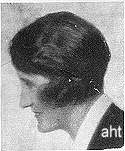THE LAND OF THE AFGHAN HOUND
(Mrs Mary Amps 1930)
The following article was originally published in "The Dog World Annual 1930".
"And when you're laid out on Afghanistan's Plains, and the women come out to cut up what remains: Just roll on your side and blow out your brains, and go to your death like a soldier."
Kipling wrote those lines many years ago of what dim land from which so few white men had set foot and returned. Yet the main routes to Central Asia then, as now, run through the teeming bazaars of her great cities, Kabul, Herat, Kandahar and Jellalabad. The rough desert track that goes from Peshewar to Kabul is drenched with the blood of British soldiers, killed in battle or fallen by the wayside from heat and thirst. Roberts' old camp still looks over the pitiless
Pheobe and Jane the first two Afghan
puppies to fly across the frontier
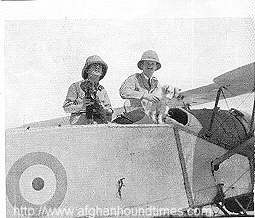 |
******Update April 2018
We recently found another publication of the above photo, this time including some details of the people in the airplane -
Captain Davidson and two of his Afghan Hounds
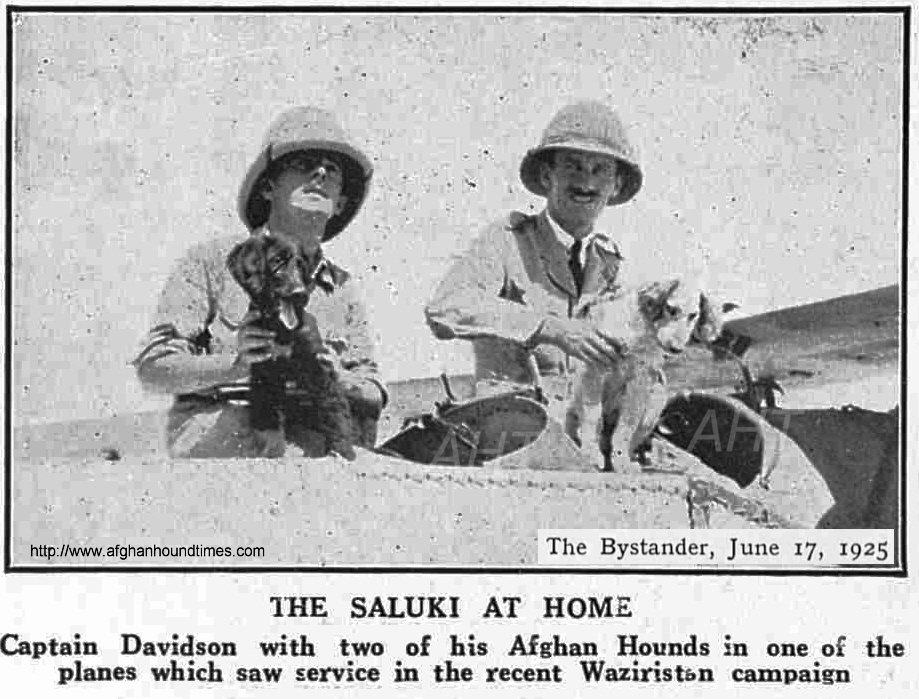 |
Here is a newsreel clip of biplanes,. like the above, in action
Burning sands to the iron hills that bar the way to British India. Legend has it that the swarms of black butterflies which greet and surround the traveler in the Jagdalak Pass are the souls of the British who fell there in the famous retreat from Kabul, when only one man got through alive. This Pass is a scene of utter desolation, no shade and no water. Cliffs, ugly and menacing, tower four thousand feet above a narrow rocky gorge strewn with scorching hot boulders that blister the skin at a touch.
At prayer the great Mosque at Kabul
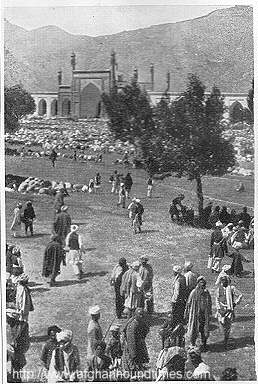 |
The torrid heat in the sandy deserts during the summer has never been computed, and in the winter the arctic cold on the uplands with deep drifts of snow and the thermometer 50 degrees below freezing point render possible the survival of only the fittest, Kabul the capital, lies some 6,000 feet above the sea. When the cold weather comes, the streets are deserted and the Kabuli retires to his thick mud-walled house to hibernate for the winter, feuds cease and fighting ends. But in this freezing city of suspicion intrigue never stops.
In the Hindu Kush 16,000 ft above the sea
Mrs. Amps with Sheik and Zulf of Ghazni,
drenched with the melting snow. Why the
Afghan has a thick wooly coat
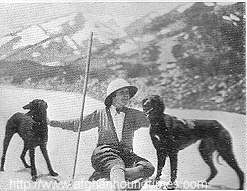 |
Travelers from all lands, Marco Polo, Friar Oderie, PereHue and Birini, have in the past related curious and picturesque happenings on their return from their necessarily prolonged journeys. We suspect they found it difficult to refrain from "garnishing the hem of truth with the embroidery of fancy." But when we step over the frontier we pass from the 20th century into the days of the Old Testament. We go back in time and custom to the Children of Israel; we must travel by stages as they did. Trains, roads and hotels do not exist. Time is held up and all our values altered. Intelligent Afghans will tell you that they are descended from the tribe of Benjamin. They certainly have a remarkably Jewish cast of countenance, and many of their customs suggest Jewish Origins.
An Afghan Village in the Kabul River Valley |
All Afghans are serious Mussulmans. Their priests, or Mullahs, possess great power, and it was their influence which finally drove Amanullah from his throne.
It is a country where the words "Took up his bed and walked" are fully understood, for nothing has the quality of permanence. The bare mud villages, surrounded by high walls and guarded by rounded tower forts are continually being razed to the ground after inter-tribal fighting. What is it that causes these people to engage in unending feuds, involving themselves, their women and their children in passionate hatred and bloodshed
As we enter Kabul we drive through alleys and by-ways, ill-paved, fortueous and silent. Windowless mud and wood houses frown down upon the passers-by with a menacing air, challenging his curiosity. Their refuse blocks the narrow drains. The Afghan when he builds is not concerned with drainage, fresh air or "ancient lights". He seeks, first and last, water and security - boons so ancient, the west has almost forgotten their significance. We step down from under the dome of the Gate Of Drums into the most fascinating and dangerous bazaar in Asia. Along the narrow streets, loosely roofed with wood and matting to keep out the heat of summer and the snows of winter, pass caravans and folk from every corner of the East: ruddy, high-cheeked Mongolians and slit-eyed Chinese, Buddhist monks from the uplands of Tibet seeking release from the Wheel Of Things, swaggering Pathans and Afridis, silken-bearded Sikhs from the Punjab, Hindu moneylenders, Merchants from Isfahan, country folk from Istalif, and Turcomans from Bokhara and Samarcand. All the lovely ancient names we read in our Arabian Night have become realities before our eyes.
Outside the old British legation wall at Kabul
Going coursing
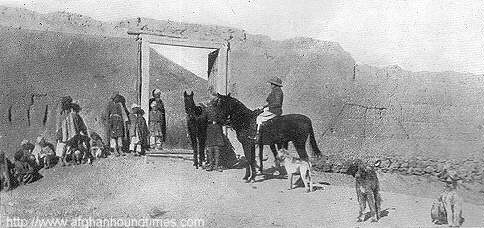 |
The shaggy Bactrian camels swing along, let by a little grey donkey after the immemorial custom of the East. The great bales on their backs are laden with silken carpets, bottles of musk and rare scents from the gardens of Persia, strange green and amber flasks of the wine of which Omar drank and sang, baskets of luscious grapes as long as ladies fingers, jade and jewels, furs and swords, and perched on top of each swaying load, a hen and a frying pan, a baby or a tin of petrol from the Anglo-Persian Oil Company
In the early dawn we ride out to the Chardeh or Wazirabad Plain to meet the headmen of the villages who have promised to show us sport with their Afghan hounds. Each village malik usually has a small pack, whilst Governors of provinces maintain large numbers of highly trained hounds, who hunt small deer called Chinkara with the aid of falcons.
This is an old form of hunting found only in Persia and Afghanistan. The hawks employed are called Chahughs. They are taken young from the nest before they have killed feathers. They are never caged, but live always on the Shikari's (hunter's) wrist, in company with the young hounds. Dogs and birds are taught to work for their food. They are fed first from between the horns of a stuffed chinkhara head, later this is drawn rapidly along a flat space on wheels, and the falcon flies to its meal.
When fully trained, the chahugh is released. The hounds are slipped immediately the bird spots the deer, which she blinds and worries. The hound quickly realises he must watch the bird. His enormous feet and sturdy frame are specially adapted to carry him over the rocky mountainous country where he brings the deer down - no easy task. There is an old saying "The first day a chinkara is born a man may catch her, the second day a fleet hounw, but on the third no one but Allah". Immediately the quarry is attacked by the hounds, mounted shikaris dash off to "hallal" the animal, for Mohammedans are forbidden to eat any living thing that has died an unclean death - that is - has not has its throat cut before it dies by a follower of the Prophet. This is called "hallal." The only creatures exempt from this curious custom are fishes and locusts, whose throats need not be cut because they possess gills. The current belief is that when Abraham was prevented by the Angel from sacrificing his son Isaac, he flung the knife away. In its passage through the air it cut the throat of a locust and then, falling into the water, that of a fish. Ever since, these creatures have had slit throats or gills and had been "hallal" without further ceremony.
The former King, Inayatullah and his son
talking to members of the British Legation
at the summer celebrations at Pagliman
Mrs. Amps is on the extreme left, Mrs. Amps on the right
 |
As time went on we were able to add some very find hounds to our kennel, amongst these were Ch Sirdar and Khan Of Ghazni. We coursed hares, foxes, and even wolves, the latter being very common in winter and early spring. The shikaris and country people are pleasant friendly folk, free from the suspicion of the Afghan townsman, and quite willing to enjoy a day's sport with the "Unbelievers". The Afghan hound in his own country is absolutely free; he passes the sheep and chickens of his village with contempt; he never riot. But the pariah dog, he sees off without any hesitation.
Khan of Ghazni looking down on the Dal Lake
in Kashmir with its floating gardens.
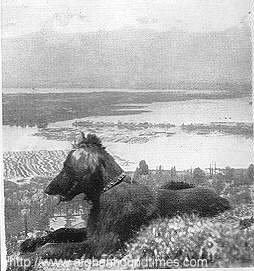 |
Afghan children are jolly little souls, many with red cheeks and fair skins, legacies left by part of Alexander's army who are said to have stayed in the country. The women are veiled and rarely seen
Coursing outside Kabul, handlers and Mrs. Amps Ghazni Afghan Hounds
 |
The country has a curious fascination. It is impossible to describe the quality of Afghan light, vivid and brilliant as a diamond, or the brown hills that thrust their ragged spurs up into the turquoise sky; singing irrigation streams flanked by rows of slender poplars; the low mud walled orchards of almond, vine and mulberry trees, the velvet loveliness of the purple petunias growing in wild profusion; the distant mauve beauty of the Judas trees at the foothills of the snow-capped Hindu-Kush; the marvelous golden dawns, and the purple and rose twilights turning the barren hills to gleaming jewels. These memories weave a spell that will linger when many more beautiful scenes are forgotten.
It may be that I shall never return to Afghanistan, but I have my Afghan hounds, handsome, courageous, faithful friends. What more could I ask of any country?
(Mrs Mary Amps 1930)
See also
Ghazni Afghan Hounds Section. Steve Tillotson 2013
Lieut-Colonel L.W. Amps and Mrs Mary Amps By Steve Tillotson and Lyall Payne Nov 2013
Lt. Amps and Mary Amps "Nice Buddha; nice set of wheels" By Llewellyn Morgan (Oxford, England Sep 2013
The Hound In Afghanistan, Mary Amps, 1932
The Land Of The Afghan Hound, Mary Amps, 1930
Mrs Amps and her famous Afghan Hounds By Phyllis Robson 1930
Robert Leighton on Mrs Amps Ghazni 1926
Afghan Hounds In India, Steve Tillotson, 2012
Afghan Controversy What is the correct type? Amps and Bell Murray
Bill Hall Meeting/Interview with Major-Genl Amps 1970's
Susan (Sirdar of Ghazni daughter)- Identity Revealed. Lyall Payne and Steve Tillotson Sept 2015
Early Afghan Hounds Section
The Origins Section
Library Of Articles/Main Menu Toolbar
Whats New Page
|
